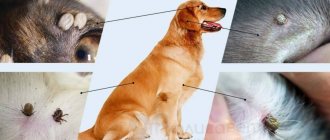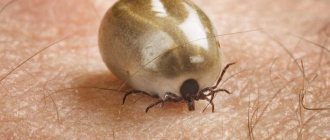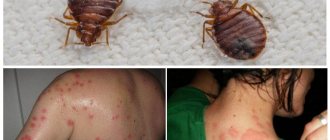Ticks in September - dangerous or not? Are they dangerous for humans? And for dogs? These questions are relevant for those who are trying to catch warm autumn days in nature with their family and pets. The danger of a tick bite should not be underestimated, because the diseases they can carry are very dangerous for humans, dogs and other living creatures. Let's figure out whether ticks pose a threat in September in the Moscow region and other regions, and how to protect yourself and your loved ones from these parasites.
Periods of maximum tick activity
Ticks are very tenacious; they are able to withstand difficult climatic conditions, provided that the air temperature is above +6-8 °C. Parasites are only afraid of frost. No, at sub-zero temperatures they do not die - they go into hibernation, as they become unable to lead an active lifestyle. When frost is replaced by warming, ticks wake up and begin to actively search for food sources.
How dangerous are blood-sucking insects?
- Ticks can transmit dangerous diseases, and this does not depend on the time of year - you can “catch” tick-borne encephalitis or borreliosis both in May and October. Many tick-borne infections can have serious consequences, sometimes resulting in death. Not all ticks are infected with dangerous infections, but it is impossible to determine this by the appearance of the parasite - the presence of infection can only be confirmed or refuted in the laboratory. That is why doctors recommend not throwing away a tick if you managed to get it, but bringing it in for analysis - if it is infected, you can take timely measures to protect your health.
- In addition to infection, you can expect other troubles from ticks - allergic reactions, irritation and inflammation. Ticks have a piercing-sucking mouthparts, thanks to which they pierce the skin and stick to a blood vessel with their proboscis. The bite itself is quite traumatic, although painless (together with saliva, the parasite releases an anesthetic substance), so the skin can become irritated, inflamed, and if parts of the tick’s body are not removed in a timely manner, suppuration can occur.
Arthropod bloodsuckers do not have visual organs, but this does not at all prevent them from perfectly orienting themselves in space and easily finding victims. Ticks have sensitive receptors that respond to odors and heat - when a potential victim appears nearby, the parasites become active and raise their four upper legs - this is a posture of readiness to cling to a passing victim. As soon as a person or animal is nearby, the tick clings to clothing/fur and begins to crawl along the victim’s body, looking for a suitable area to bite. This search can take from a few seconds to 2 hours. Males quickly eat enough and fall off on their own, and females can drink blood for up to 10 days, all this time being on the “host’s” body.
Table of tick activity by month
| Months | Tick activity | Phase description |
| April | 100% | First phase of activity. Ticks begin to wake up after hibernation when the air warms up to +6-8 degrees. It is impossible to name the exact date of mite activation; it directly depends on temperature and climatic conditions. After hibernation, bloodsuckers are most aggressive because they are hungry. They begin to actively search for the food they need for development and reproduction. |
| May | 98 % | |
| June | 87 % | In summer, the activity of bloodsuckers decreases, and temporary physiological rest occurs. Parasites can attack people, they just do it less often. Since they do not like heat, they usually wait for victims in the shade. |
| July | 75 % | |
| August | 85 % | |
| September | 92 % | Second phase of activity. During this period, the aggressiveness of ticks increases again, as they prepare for hibernation - before winter they need to be completely satisfied, so the parasites search for food with diligence. |
| October | 97-100 % | |
| November-March | <10 % | Hibernation. Provided that the air temperature does not rise above +6 °C. |
Important: a tick can bite even in January under certain conditions. Parasites can get into the heat, warm up and begin to become active - for example, ticks can be brought into a house on a Christmas tree from the forest, and parasites can also hide in the hay that is stored in villages for the winter.
Tick-borne borreliosis
With this disease, external symptoms appear, in which the site of the attack turns red, a clear outline appears, and swelling appears. Then the redness subsides, the spot becomes pale and a bluish tint appears.
The first symptoms may appear after 30 days. External symptoms disappear after 2 weeks. Next, the virus begins to infect the brain, cardiovascular system, and blood vessels. The virus can remain in the body for 2-3 years and not make itself felt, causing irreparable consequences.
At what temperature do ticks disappear?
- Parasites do not like dry and hot weather. The ideal temperature for the comfort of parasites is up to 21 ° C, and high humidity is required - 55% or higher. If there is practically no precipitation in the summer and it is very hot, the likelihood of encountering a tick is reduced (but not excluded). In such weather, they prefer to hide in damp shady places, all kinds of ravines and crevices; large populations are found in mixed and deciduous forests - here the conditions for development and reproduction are ideal.
- It is believed that the tick season ends with the onset of negative temperatures. In fact, tick activity begins to decline in the fall, when the air temperature constantly remains at +3...+5 degrees and below. In cold weather, the parasites fall into suspended animation, and after wintering they will be able to wake up and again attack people and animals.
- After winter, ticks begin to wake up when the air warms up to +1...+3 °C, and become active at +10 degrees. Accordingly, the tick season in different places begins at different times - it all depends on weather conditions; in some places the parasites will begin to attack in March, in others in April.
Tick-borne encephalitis
Once in the body, the infection goes through an incubation period, after which the first symptoms of the disease appear. The period for symptoms to appear may vary; after an encephalitis tick bite, it can take from 3 days to 3 months until signs of infection begin to appear.
They are very similar to the symptoms of a cold or flu, so it is very important to remember the attack and consult a doctor immediately.
A person feels severe weakness, body temperature rises, headaches, joint aches, and drowsiness begin. Then the symptoms disappear for a while, and if a person took cold medicine, he thinks that he has simply been cured.
But in fact, the virus attacks the nervous system and brain. This leads to paralysis of the limbs and impaired motor activity. The disease can lead to decreased mental activity, muscle atrophy, and in severe cases, death.
How to protect yourself from tick attacks
Avoid places where parasites may be present
Ticks love shaded areas; they accumulate in large numbers in damp forests and shady city parks. Favorite places are areas with tall grass, bushes, ditches, banks of rivers and lakes, and the edges of forest paths.
Dress properly
Wear light-colored clothes made of thick fabrics, choose things with long sleeves and trouser legs. Light-colored clothing will make it easier to spot the parasite. You need to wear a hat; in the forest, wear a hood - it will protect both your head and neck. Wear closed shoes, preferably high ones, so that you can tuck your trousers into them (they can also be tucked into your socks). Fasten the buttons on the cuffs. The fewer exposed areas of the body, the less chance the tick has of reaching the skin and biting.
Check your clothes and body regularly
When a parasite clings to clothing (or the fur of an animal), it does not attach itself instantly. He spends some time trying to find a suitable area with delicate skin that he can bite through. The more covered by clothing, the less likely the tick is to find a suitable place before you notice it.
Inspect your clothing and body every 20-30 minutes while walking in the woods or other areas where ticks may be present. Pay special attention to areas with delicate skin - the armpits, neck, head, areas under the knees, groin. Inspect your pets; if you are walking in a group, conduct mutual inspections.
Use protective drugs
To protect against ticks, there are special preparations that can be used to treat skin and clothing before walking in a potentially dangerous area. The preparations are different, so read the instructions carefully - some can be applied to the skin, others can only be applied to clothing. Each product has its own expiration date, after which the protective layer must be renewed.
Carry a tool to safely remove ticks
No anti-tick drug provides a 100% guarantee against a bite. Unfortunately, the parasite can bite even if you are dressed correctly and take all precautions. And if you don’t follow everything, the likelihood of a bite increases significantly.
It's bad if a tick bites. It's good if you have a tool with you to safely remove the parasite. Why is it safe? Because if you pull a tick with your hands, threads or tweezers, you can damage its body, and then the head will remain under the skin, infectious pathogens will continue to enter the blood, and the bite site will become inflamed. If a tick is removed correctly and quickly, even if it is infected, a minimal amount of harmful microorganisms will enter the bloodstream, and with adequate treatment there will be no or minimal consequences. A tick card is a special tool for removing ticks in any conditions. It can be used in the forest, park, at home - anywhere, as soon as you notice a tick attached. Lightweight and compact, it will fit in your wallet or bag pocket. The tick card works simply - you need to pry the parasite with a special groove and carefully pull it out. The kit includes an alcohol wipe (for disinfecting the wound) and a test tube (for delivering the tick to the laboratory for analysis).
Ticks remain carriers of infection in any season; encountering them is dangerous in every month. a Tick Card with you !
Removing the Parasite
If after going to the forest a tick is found on your body, you need to remove it. The main thing is not to panic and do everything right. Pressing or pulling on it is strictly prohibited. The best option is to go to the clinic for qualified help.
If this is not possible, then the bite site should be lubricated with a thick cream. Then make a loop of strong thread and, using it, swinging from side to side, carefully remove the tick. It is very important not to crush it so that the pathogen does not enter the bloodstream.
It is impossible to determine by the type of insect whether it is a carrier of the disease. Therefore, you should put it in a bag and take it to a medical laboratory for testing to make sure that it is not the source of an infectious disease.
You can also use tweezers to remove the tick. After the procedure, the wound should be treated with a disinfectant solution. If a situation arises where the insect's proboscis remains at the site of the bite, nothing else needs to be done. The remains will be eliminated by the body itself. After removing the tick, you should wash your hands with soap.
our history
This happened in the very early nineties, when piroplasmosis in dogs was a rarer disease than it is today. Not all veterinarians even knew how to treat such dogs. While they were dealing with the cause of the illness, the animals weakened and died before our eyes. Autopsies showed damage to various organs that were incompatible with life. Information about such cases quickly spread among dog owners. Everyone was afraid to see “cherry” urine and understood that only urgent measures could save him. Which? No one knew. In the Moscow high-rise building where we lived, a dog died, which was taken to a veterinary clinic almost every day for a week, where blood was drawn, IVs were placed, and a variety of medications were administered for supposed diseases.
Our young Schnauzer fell ill with piroplasmosis in mid-October. Autumn that year was nasty. At first it was cold but dry, then it started to snow.
On the weekend, when the weather improved a little, we went with our two young Schnauzers to a village in the Kaluga region. The dogs happily ran through the meadows, moused and enjoyed freedom. On Sunday evening everyone returned to Moscow. On Wednesday we noticed that one of the little cats began to eat worse and behave suspiciously calmly. The veterinarian we spoke with over the phone advised us to continue monitoring the dog’s condition and take its temperature. On Thursday morning we sounded the alarm: the urine had turned cherry in color!
Through my friends, I managed to quickly reach an agreement with a very good doctor at the veterinary academy. By noon the dogs were already in the laboratory. The patient immediately underwent a rapid blood test. I saw in the microscope eyepiece how actively the destruction of red blood cells was taking place. It was scary, because the pathogen spreads very quickly throughout the body. For the second dog, everything turned out to be within normal limits.
The very first injection stopped that destructive process. It’s hard to believe, but after a couple of hours we were taking home a completely active dog. They gave us an ampoule of medicine with us so that we could get a second injection at home exactly 24 hours later. Everything ended well, the little girl lived to be almost 14 years old. In my “dog” notebook, which is still preserved, the drug Berenil is written in handwriting, uneven from excitement, with Azidine in parentheses.
Unfortunately, only a few doctors could treat piroplasmosis at that time. Later, modern medications began to be used, which have fewer side effects. Reliable means of protection have appeared, and a successful treatment method has been developed. But even today dogs die from piroplasmosis. This often happens during the season when their owners are confident that there is no tick danger.
It must be remembered that ticks pose a threat all year round. In some seasons they are more active, in others there is less chance of running into a hungry tick.
You need to know the enemy by sight
- So, the most important thing is that ticks are as active in September as they are at the end of spring. An excellent sense of smell helps ticks find a food source in the forest. You can determine whether a tick is hungry or not with the naked eye. When it is full, its body enlarges and takes on an egg-shaped shape, changing color from brown to red. Until then, his “figure” is flat and has a pale appearance.
- The body of the parasite has a head and a body. The peculiarity of the structure of its skin allows it to absorb large amounts of blood and increase its mass 100 times. This effect is achieved due to the fact that the hard covers of the bloodsucker’s body alternate with elastic ones, gathered into folds.
- There is a protective shield on the top of the body. In males it covers the entire body, but in females it covers only part of it.
- These arachnids have 4 pairs of limbs. Each of them ends with a claw and a sucker. It is thanks to this that they move freely through trees and bushes, human clothing and animal fur.
- Visually, males and females differ both in size and color: males are smaller than females, their integument is brown. The shield of the female tick is also brown, and the rest of the body is brown.
A hungry tick is flattened and brownish in appearance.
Attention! Ticks are quite common in the Moscow region in September. The tick has a sharp proboscis. It can remain in the victim’s body for quite a long time. This statement is especially true for females.
Atypical case
An adult guard dog I know fell ill with piroplasmosis in January. The owner put fresh hay in the booth, which was stored in a warm barn. There was a tick in it.
A couple of years ago, a veterinarian I knew cured a dog of piroplasmosis in December. She was usually walked in Moscow on thawed patches above the heating pipeline. Even in winter there was little snow there; land with a green lawn was often visible. In such comfortable conditions, the tick was waiting for its victim.
In stables and barnyards, where fragrant hay is not stored in freezing sheds, similar cases also occur. Late autumn, winter and early spring are no longer safe periods when we are sure that there are no ticks. And there are more and more of them every year. These parasites threaten the health of not only dogs, but also people. The statistics are terrifying. Recently, a veterinary website warned of a new threat caused by ticks.
Methods of safety and control of tick bites
Considering that ticks are active at any time of the day, you must always use means of protection against them, as well as select the most suitable control methods. Such measures are taken before the parasites go into hibernation - throughout the entire warm period of the year.
Folk remedies
The most common option is essential oil. Use a concentrated substance and apply it pointwise to things. Another solution is prepared: a few drops of essential oil are mixed with water. It is used to treat clothes before going outside. Another recipe:
- Mix the ingredients: 2 glasses of vinegar, 1 glass of water, essential oils (citrus and eucalyptus) - 10 drops each.
- The solution is poured into a spray bottle.
- Clothes are processed before going outside.
Essential oil with water against ticks
Sprays, repellents, ointments
If you happen to live where there is a high level of endemic danger, it is recommended to use more effective means:
- Moskill – acaricidal drug (spray);
- Gardex - represented by a line of products for people of different age categories, produced (spray);
- Tornado anti-mite (spray);
- Pretix (chalk);
- Off Extreme (aerosol);
- Barrier (cream);
- Lesovik (cream).
The concentration of the active component is low, which does not allow the destruction of pests. Sprays and aerosols often exhibit acaricidal properties - they kill ticks upon direct contact with the treated areas
Moreover, it is important to re-treat in time, when several hours have passed since the substance was sprayed
Effective remedies for taiga ticks
Smoke bombs, solutions
There are preparations intended for irrigating crops to kill parasites. This is done if the grass is mown, but parasites still appear. Additionally, such drugs help destroy other pests (mosquitoes, midges). They are sprayed outdoors and do not harm crops, people or animals. Examples of smoke bombs: Quiet Evening, City, Samuro.
Smoke bomb against parasites
Clothing against ticks
To avoid having to leave the forest ahead of time (for example, if the repellent has worn out), you can prepare a special suit in advance. Such clothing completely protects the entire body and even the head thanks to the presence of a hood and mosquito net. There are cuffs and muffs on the sleeves and trousers. The lower part of the jacket is tucked into the pants. The hem of the trousers should also be hidden in the shoes. The material is quite smooth, which does not allow the parasite to climb up to its favorite areas of the skin.
Protective suits against ticks
Vaccination. When is the best time to get vaccinated against ticks?
This measure will help avoid the development of complications due to encephalitis infection. In addition, vaccination helps reduce the risk of infection. Statistics show that vaccinations are effective in 95% of tick attacks. In addition, this measure helps prevent the development of other dangerous diseases transmitted by ticks.
It is recommended to get vaccinated no later than 1 month before going out into nature or traveling to regions with a high risk of endemic danger. This assumes the need to undergo two stages of vaccination with a break of 2 weeks to 7 months between them.
Video: Vaccination video
If you have additional questions about the administration of a drug containing inactivated tick-borne encephalitis virus, you can watch the video.
Habitats
At home, ticks most often settle in beds.
The main reason is the availability of food. Bed pests feed on particles of exfoliated skin and sweat. Optimal living conditions are warmth, humidity, and the absence of bright sunlight. In a person’s bed, all these conditions are met. Mattress mites settle in furniture, soft toys, interior items, and remain on any surface where a large layer of dust accumulates. It's safe to say that furniture mites are everywhere, always and everywhere. The ideal place is an unmade bed, an old mattress, feather pillows, unwashed bedding with particles of dandruff, skin, and sweat.
Bed or dust mites











